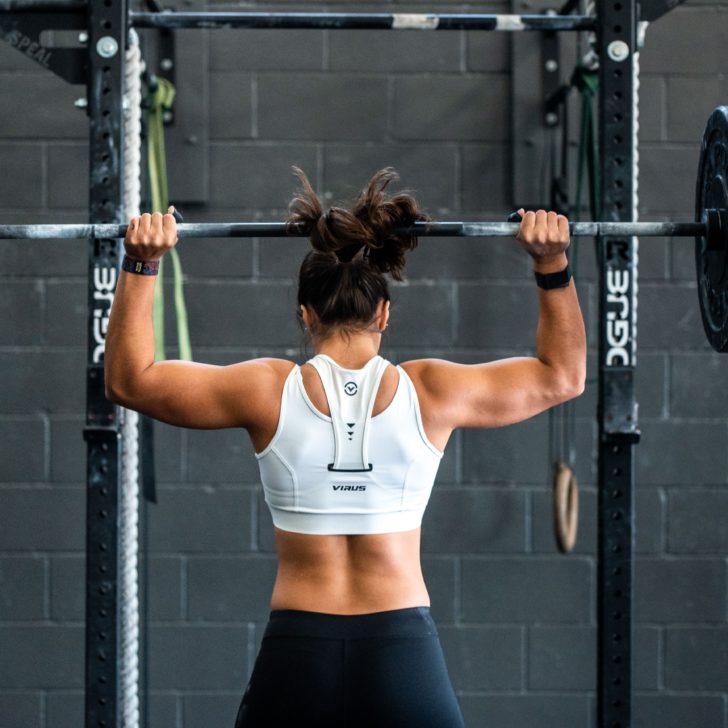Although the bench press or squat may come to mind when you think of barbell exercises, there are many different types of barbells workouts that can be effective for your fitness goals.
In this comprehensive guide, we’ll discuss the benefits of each type of barbell and provide examples of exercises you can do with them. Let’s get started!
13 Different Types of Barbells

Barbells are cylindrical pieces of equipment that are commonly used in weight training and strength training workouts.
They consist of a long, straight shaft that is attached to two collars at either end, which hold the weights in place.
On one end of the barbell, there is a grip that allows you to easily hold and lift it. Depending on their intended use, barbells can be made from different materials and come in various sizes and weights.
Barbells are used for a variety of exercises, including squats, deadlifts, bench presses, bicep curls, and many others.
1. Hybrid/Standard Barbell

This type of barbell features a combination of standard and Olympic plates, which allows you to easily adjust the weight according to your needs.
The handles on this barbell are also designed to be comfortable and easy to grip, making it a great choice for both beginners and more experienced weightlifters.
One of the main benefits of using a hybrid/standard barbell is that it allows you to perform a wide variety of different exercises.
You can use it for traditional barbell lifts like the squat, bench press, or deadlift, as well as more advanced exercises like kettlebell swings or farmer’s carries.
Additionally, this type of barbell makes it easy to quickly switch between weights, which can help you keep your workouts challenging and prevent plateaus from developing over time.
| Pros | Cons |
| Allows you to easily adjust the weight and perform a variety of different barbell exercises. | Not recommended for powerlifting or olympic lifting. |
| Comfortable and easy to grip, making it a great choice for both beginners and more experienced weightlifters. | – |
Exercises For The Standard Barbell
Bench Presses
Bench presses are another great exercise for a hybrid/standard barbell because they work several major muscle groups at once, including the chest, shoulders, and triceps.
This makes them an ideal option for increasing upper body strength and power, which can help you perform other movements with more efficiency and ease.
Pull-Ups
Pull-ups are also a great choice for those working with a hybrid/standard barbell because they engage multiple muscle groups in the back, arms, shoulders, and core all at once.
Additionally, they require minimal equipment so you can do them almost anywhere, making them convenient to incorporate into your routine.
Bent-Over Rows
Bent-over rows are another excellent exercise that targets multiple major muscle groups in the back, arms, shoulders, and core while also helping to develop functional strength in these areas.
To perform this exercise with a hybrid/standard barbell:
- Simply stand with your knees slightly bent while holding the bar on either side of your hips or thighs with an overhand grip.
- Then, bend forward from your hips until your torso is nearly parallel to the ground before lifting the bar toward your chest until it’s roughly even with your sternum or waistline.
- Pause briefly before lowering back to starting position to complete one repetition.
2. Fixed Bar
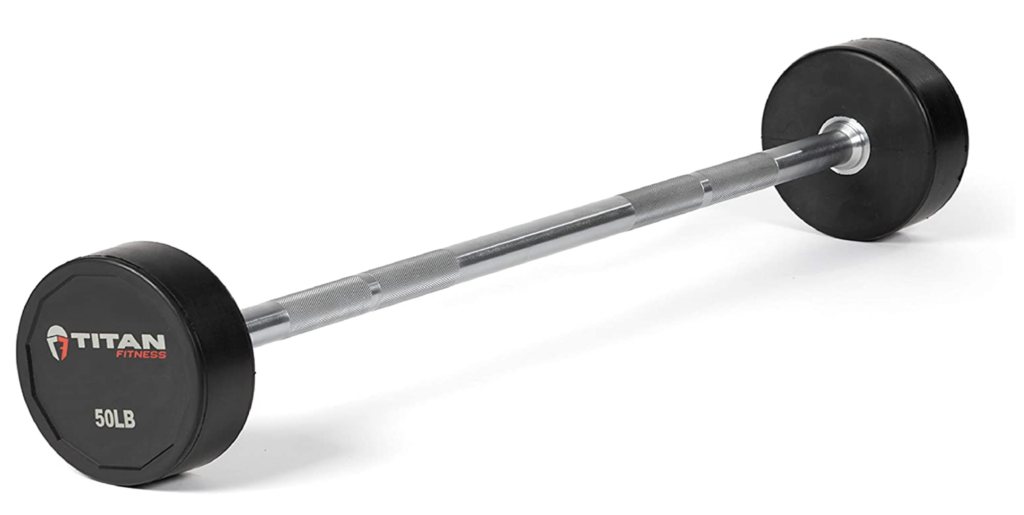
A fixed barbell is a type of barbell that features a single, unchanging weight. Unlike hybrid/standard barbells, the weight cannot be adjusted, so it is used for more focused strength training workouts.
It is commonly found in commercial gyms and typically increases in 10-pound or five-kilogram increments, allowing users to gradually increase their workout intensity over time.
| Pros | Cons |
| It allows you to focus on building strength in a specific muscle group or movement pattern. | Fixed bars may not offer enough variety in your routine, limiting your ability to target different muscle groups or work on specific areas of strength and conditioning. |
| A fixed bar allows you to focus on developing strength and power in a specific part of your body, rather than spreading your energy across multiple exercises or areas. | Because fixed bars do not have any moving parts, they can wear down over time and require frequent replacement to ensure proper functionality. |
| Ideal for those who are new to strength training or are looking to refine their technique. Also, because the weight is unchanging, it can be easier to control your movements. | – |
Exercises For The Fixed Bar
Bicep Curls
Bicep curls are a great choice for targeting the smaller muscles of the upper body like biceps and forearms when using a standard/hybrid barbell since they require very little space or equipment to perform effectively.
Overhead Presses
To perform this exercise:
- Stand with feet shoulder-width apart and hold the bar in front of you at about chin height with palms facing forward or slightly inward so that they’re just below shoulder level.
- Then, extend your arms straight up overhead before returning them to starting position to complete one rep.
3. Powerlift Bar
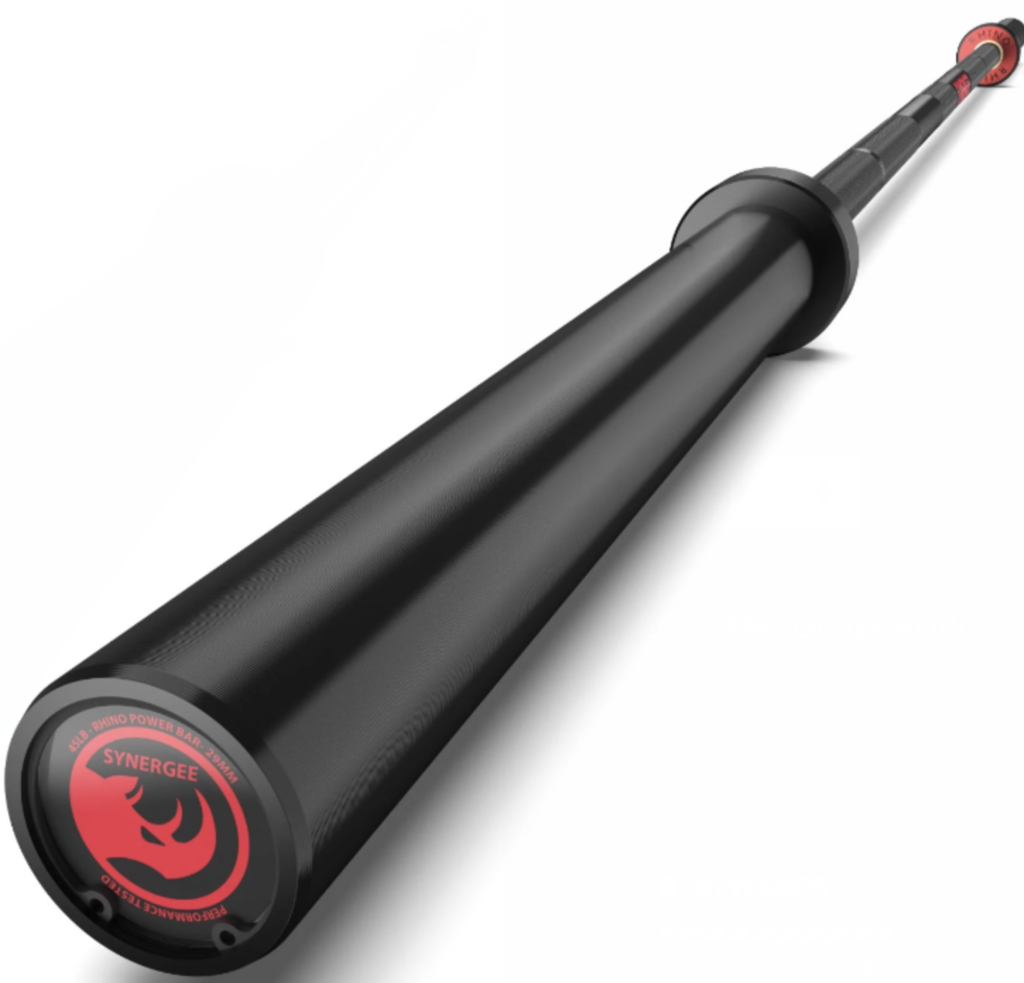
A powerlift bar is a type of heavy-duty barbell designed specifically for use in powerlifting competitions.
These types of bars feature extra knurling on the grip area to help improve your gripping strength and reduce slippage during heavy lifts, as well as a center knurling for use with squatting movements.
Because powerlifting bars are specially designed for lifting heavy weights, they are typically longer and thicker than standard or hybrid barbells, offering increased stability and balance during heavy lifts.
| Pros | Cons |
| Powerlifting bars can help you achieve greater gains in strength and power by allowing you to safely and effectively lift heavier weights. | Powerlifting bars are typically quite expensive, so they may not be a feasible option for those on a tight budget. |
| If you’re serious about powerlifting, using a barbell specifically designed for these types of lifts can help you take your training to the next level. | They may not be suitable for use in other types of strength training workouts that don’t involve lifting heavy weights. |
Exercises For The Powerlift Bar
Heavy Squats
One of the most popular exercises to perform with a powerlift bar is heavy squats.
To do this exercise:
- Position the bar on your back just above your traps, keeping your feet shoulder-width apart and toes pointing slightly outward.
- Lower into a deep squat position, keeping your core engaged and back straight as you press through your heels to stand back up.
- Repeat for reps as desired.
4. Earthquake Bar
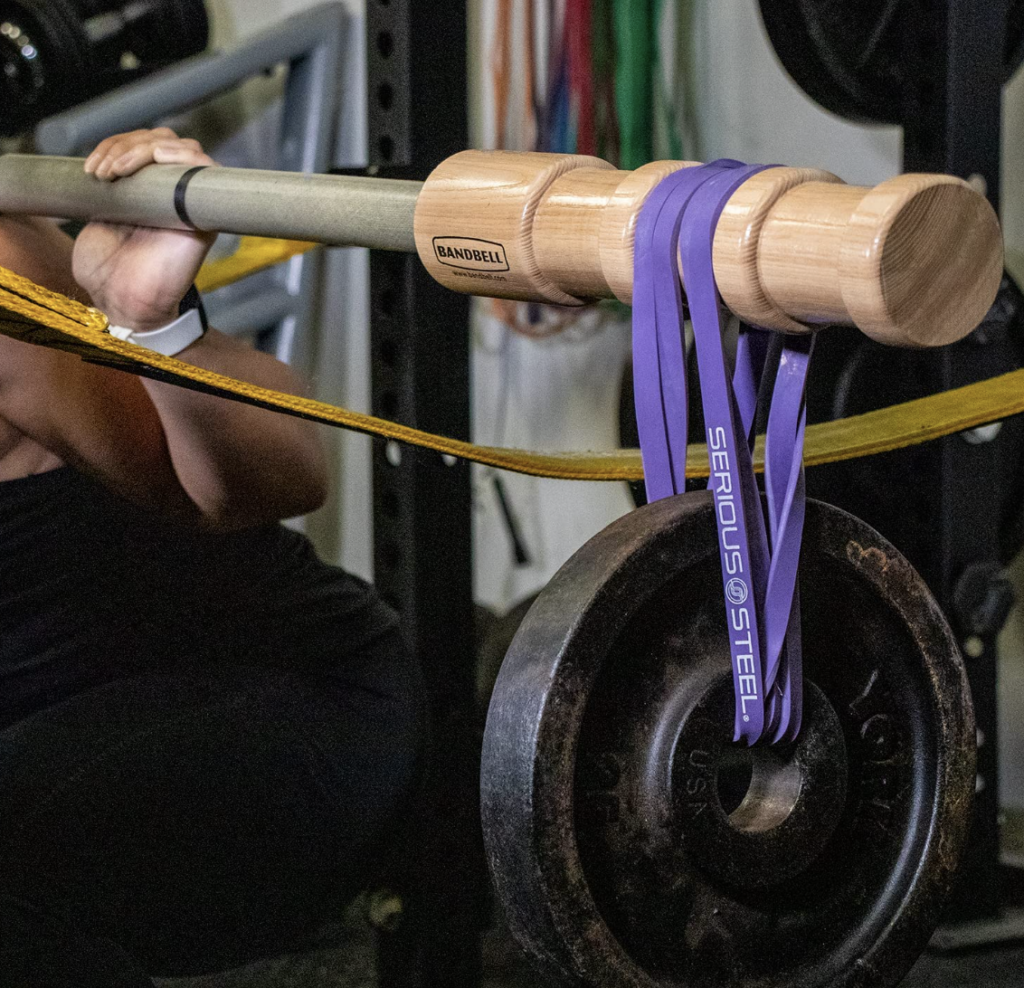
An earthquake barbell is a type of specialty barbell designed specifically for use in intense bodyweight training workouts like CrossFit and calisthenics.
These types of barbells feature multiple grips on each side to allow you to perform a variety of different exercises with just one piece of equipment.
Because earthquake barbells flexibility and versatility, they can be a great choice for those looking to maximize their results from bodyweight training exercises.
| Pros | Cons |
| One of the main benefits of using an earthquake barbell is the increased range of motion that you get with different types of grips. | Earthquake bars may not be well-suited for all types of exercises or users, as they may be too challenging for some people |
| Because the bar is designed to mimic the natural movements of the body when performing various exercises, it allows you to safely push yourself to your limits without putting undue stress on your joints or other parts of the body. | – |
| In addition to providing support during exercise, an earthquake bar also helps prevent injuries by letting users maintain proper form and alignment throughout their workouts. | – |
Exercises For The Earthquake Bar
Static Holds
One of the most popular exercises to perform with an earthquake bar is static holds.
- Start by holding the barbell in a chin-up position, with your hands positioned slightly wider than shoulder-width apart.
- Engage your core and slowly lower yourself down so that your body is parallel with the ground, holding this position for as long as possible.
- Focus on keeping your form and body alignment steady throughout this exercise, even as you feel your muscles start to fatigue.
Zercher Squats
Another great exercise to try with an earthquake bar is zercher squats.
- Begin by holding the barbell in a squat position, positioning it just below your belly button in the crooks of your elbows.
- Lower yourself down into a deep squat, keeping your back straight and core engaged as you press up to standing.
- Repeat for reps as desired, focusing on maintaining proper form and alignment throughout the movement.
5. Trap Bar/Hex Bar
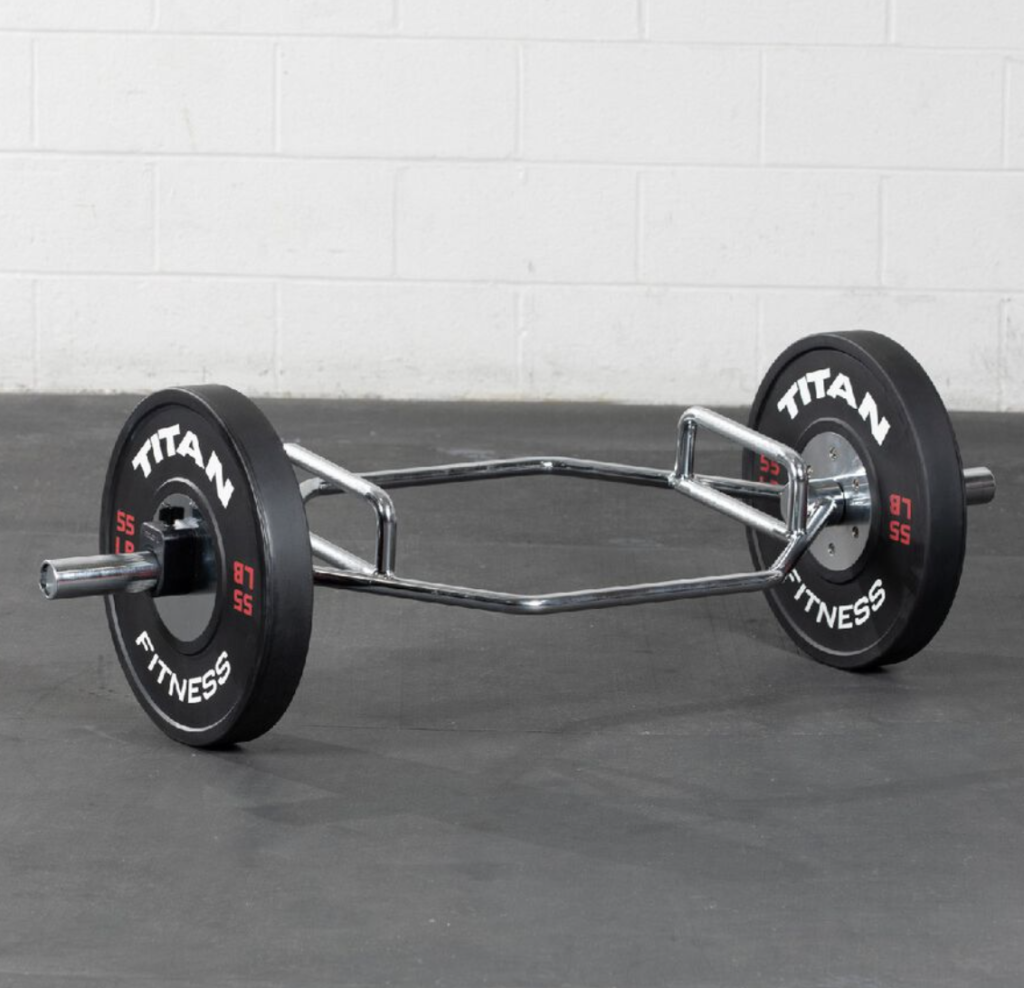
If you are looking for an alternative to traditional barbells, the trap bar or hex bar may is certainly a different type of barbell for you.
This type of barbell is designed to allow for a more comfortable, ergonomic grip that better accommodates the natural shape of your body.
This piece of equipment consists of two long, curved bars that are secured together at one end, and it can be used for everything from squats and deadlifts to bench presses and rows.
Compared to traditional weightlifting equipment like dumbbells or barbells, the hex bar/trap bar offers a number of benefits, including better balance, more stability, and easier loading and unloading.
| Pros | Cons |
| One of the main benefits of using a trap bar is that it can help to reduce strain and discomfort in your wrists, back, and shoulders. | One potential drawback of using a trap bar is that it may not be as versatile as other types of weightlifting equipment. |
| Another advantage of the trap bar is that it allows you to lift more weight than you could with a traditional barbell, making it ideal for those looking to build muscle and strength. | You will likely need to work with a personal trainer or coach in order to learn how to properly use the trap bar for different types of workouts |
Exercises For The Trap Bar/Hex Bar
Floor Presses
- Begin by lying flat on your back on the floor, with your feet flat on the ground and the trap bar resting on your chest.
- Using a slow, controlled movement, press the weight up until your arms are fully extended.
- Lower the weight back down to the starting position and repeat.
Staggered-Stance Deadlift
- Start by standing with your feet shoulder-width apart, with one foot positioned slightly in front of the other.
- Grasp the trap bar with an overhand grip, and slowly lower it down until your upper thighs are nearly parallel to the floor.
- Engage your glutes and hamstrings to lift the weight back up.
6. Arched Bar/Cambered Bar
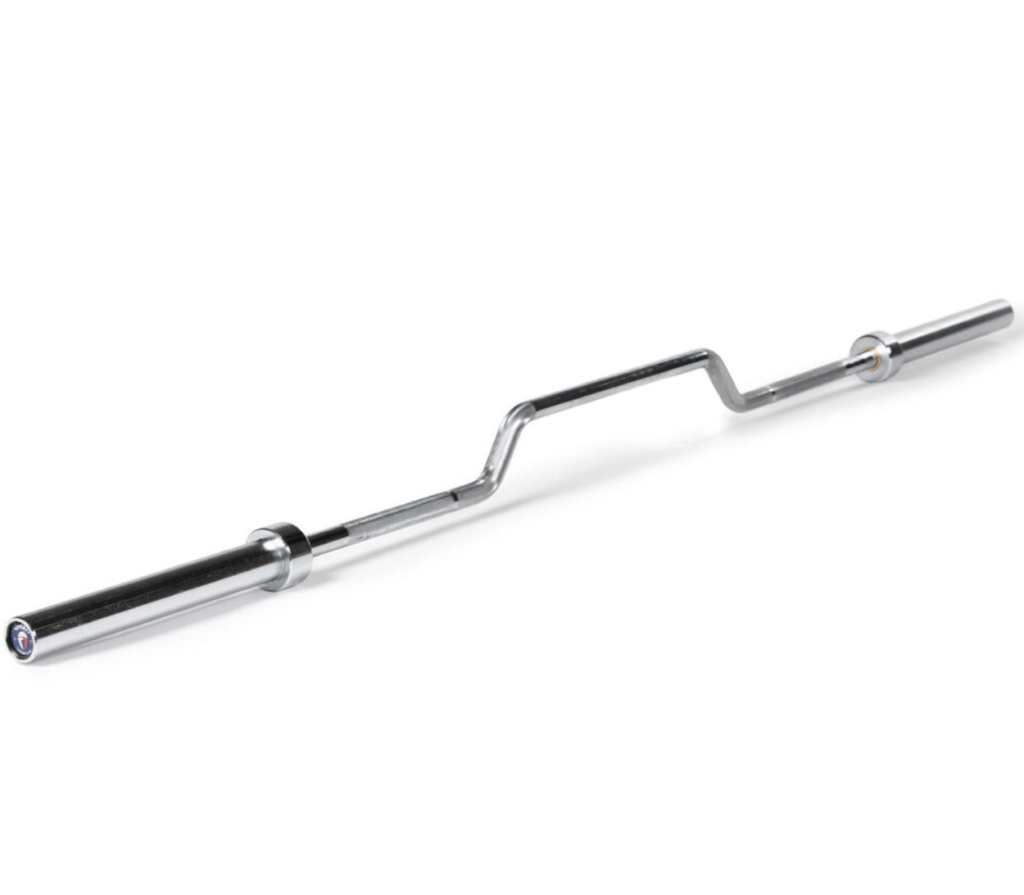
The Arched Bar/Cambered Bar is an exercise that uses two bars of different heights to perform a variety of strength training movements.
This type of bar allows you to move freely through a range of motion, engaging multiple muscle groups and building strength and flexibility.
| Pros | Cons |
| An arched bar or cambered bar is designed to better match the natural biomechanics of the body. | Some people may find that these bars do not provide enough challenge or variation compared to other equipment options, limiting their effectiveness for individuals who have already mastered more basic exercises. |
| Another advantage of using an arched bar or cambered bar is that it can reduce strain on the joints, particularly the wrists and elbows. | – |
| Arched bars or cambered bars can be used with a wide range of equipment, including free weights like dumbbells and kettlebells. | – |
Exercises For The Arched/Cambered Bar
Cambered Bar Squats
- Begin by standing with your feet hip-width apart and holding an arched bar or cambered bar in front of your chest.
- Slowly lower your body down into a squat, keeping your back straight and maintaining control of the bar.
- Press through your heels to return to the starting position, engaging your glutes and quads. Repeat for reps, then switch sides.
Cambered Bar Rows
- Start by sitting on the floor with your legs extended and an arched bar or cambered bar resting on the ground in front of you.
- Grasp the bar with a wide overhand grip, and slowly lift it up until your arms are fully extended.
- Engage your back muscles to slowly lower the bar back down to the starting position, keeping your upper body still and controlled throughout.
7. Deadlift Bar
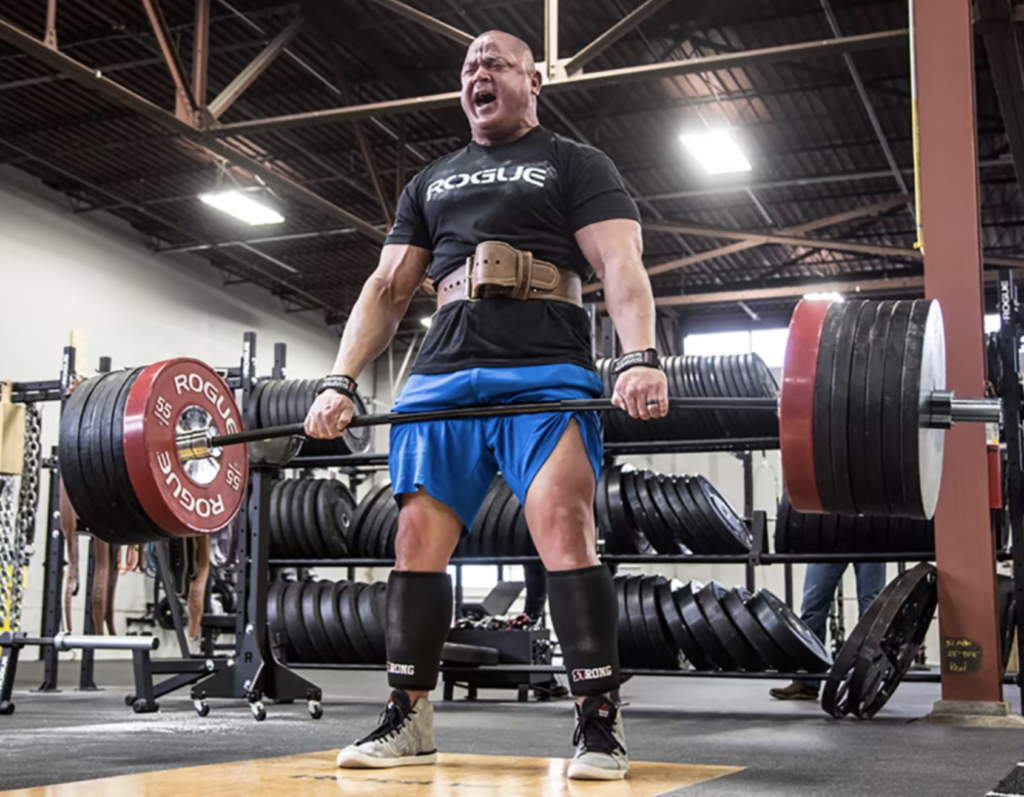
A deadlift bar is a specialized piece of equipment that is commonly used in the gym for lifting heavy weights.
This type of bar has extra thick grips to allow you to comfortably hold onto the weight while lifting, and it also has a smaller diameter than other types of bars, which helps to reduce the amount of stress on your wrists and forearms.
Additionally, some deadlift bars are designed with extra wide spacing between the plates, which can help you better engage your back muscles as you lift.
| Pros | Cons |
| The bar itself is longer than a typical barbell, allowing you to load more weight onto the bar without sacrificing range of motion or stability. | One potential drawback of using a deadlift bar is that it can be more challenging to get into the right position, particularly when lifting heavier weights. |
| Many people find that using a deadlift bar helps reduce strain on their lower back, which can otherwise be a common problem when performing this type of lift. | – |
Exercises For The Deadlift Bar
Heavy Deadlifts
- Begin by standing in front of a loaded deadlift bar, using your preferred stance and grip.
- Grasp the bar with an overhand grip, keeping your hands slightly wider than shoulder-width apart.
- Slowly lower the bar down until you feel a slight stretch in your hamstrings.
- Then engage your glutes and core to lift the weight back up.
8. Olympic Barbell

Another different type of barbell is the olympic barbell is a long, cylindrical bar typically made of steel or another heavy metal.
It is used in a variety of weight lifting and strength training exercises, such as bench presses, squats, and deadlifts.
The barbell can be loaded with weight plates on either end to increase the resistance and intensity of the workout.
Its design makes it ideal for these types of exercises, as the weight can be evenly distributed along its length for better balance and control.
The free ends of the bar allow users to easily pick up and move heavy weights with ease.
| Pros | Cons |
| Using an olympic barbell helps build strength in the forearms and hands due to the fact that you need to grip tightly in order to maintain control over the weight as you lift it up and down. | Using an olympic barbell is that it can be fairly intimidating for beginners, as it is typically used by more advanced weight lifter |
| This type of bar is also a great tool for increasing your overall strength and power, as it allows you to safely lift heavy weights without compromising form. | Additionally, the size and weight of the bar can make it inconvenient to transport or store. |
Exercises For The Olympic Barbell
Snatch
To perform a snatch using an olympic barbell:
- Start by standing with your feet hip-width apart and your hands slightly wider than shoulder-width apart.
- Begin by lifting the bar off of the ground or a rack, then moving into a low squat position with your back flat and your core engaged.
- In one swift motion, lift the bar by extending your hips and knees, keeping your back straight as you rise to a standing position.
- Carefully lower the bar back down to the ground, and repeat as needed.
Sumo Lifts
A sumo lift is a variation of the classic deadlift, and it involves standing with your feet positioned wider than shoulder-width apart.
- Grasp the barbell with an overhand grip, keeping your hands slightly wider than shoulder-width apart.
- Slowly lower the bar until it is just below your knees.
- Then, engage your glutes and core to lift the weight back up to a standing position.
Power Cleans
To perform a power clean using an olympic barbell:
- Start by standing with your feet hip-width apart and holding the bar at arm’s length in front of your thighs.
- Keeping your core engaged and back flat, bend at the waist to lower the bar towards the ground.
- Then, use your hips and legs to explosively lift the bar up towards your chest, using an overhand grip to guide it up.
- Finally, lower the bar back down to the ground and repeat as needed.
9. Axle Bar

This bar is typically comprised of heavy-duty steel or another sturdy material, and it features a thick center sleeve that sits on top of the barbell’s core.
This sleeve helps to distribute the weight evenly across the entire surface area of the bar, ensuring that you can safely and effectively lift heavier weights for your exercises.
| Pros | Cons |
| An axle barbell provides a wider, more comfortable grip than other types of barbells. | One major disadvantage of an axle barbell is that it may be more difficult to grip than a standard barbell, particularly for smaller or weaker users. |
| The solid construction of an axle barbell also makes it more durable than other types of barbells, allowing it to withstand heavy use without developing cracks or breaking. | Another potential drawback of using an axle barbell is that it may not be available at all gyms or fitness centers. |
| Its weight is distributed evenly along its length, making it more balanced and stable during exercises like the bench press or overhead press. | – |
Exercises For The Axle Bar
Axle Bar Clean Press
To perform the axle bar clean press:
- Start by standing with your feet hip-width apart and holding the barbell at arm’s length in front of your thighs.
- Bend at the waist to lower the bar towards the ground, keeping your back flat and core engaged throughout the movement.
- Then, use your hips and legs to explosively drive the bar upwards towards your chest, using an overhand grip to guide it up.
- Once the bar is at chest height, use your arms to guide it up towards your shoulders.
- Finally, lower the bar back down to the ground and repeat as needed.
10. Curl Bar/EZ Bar
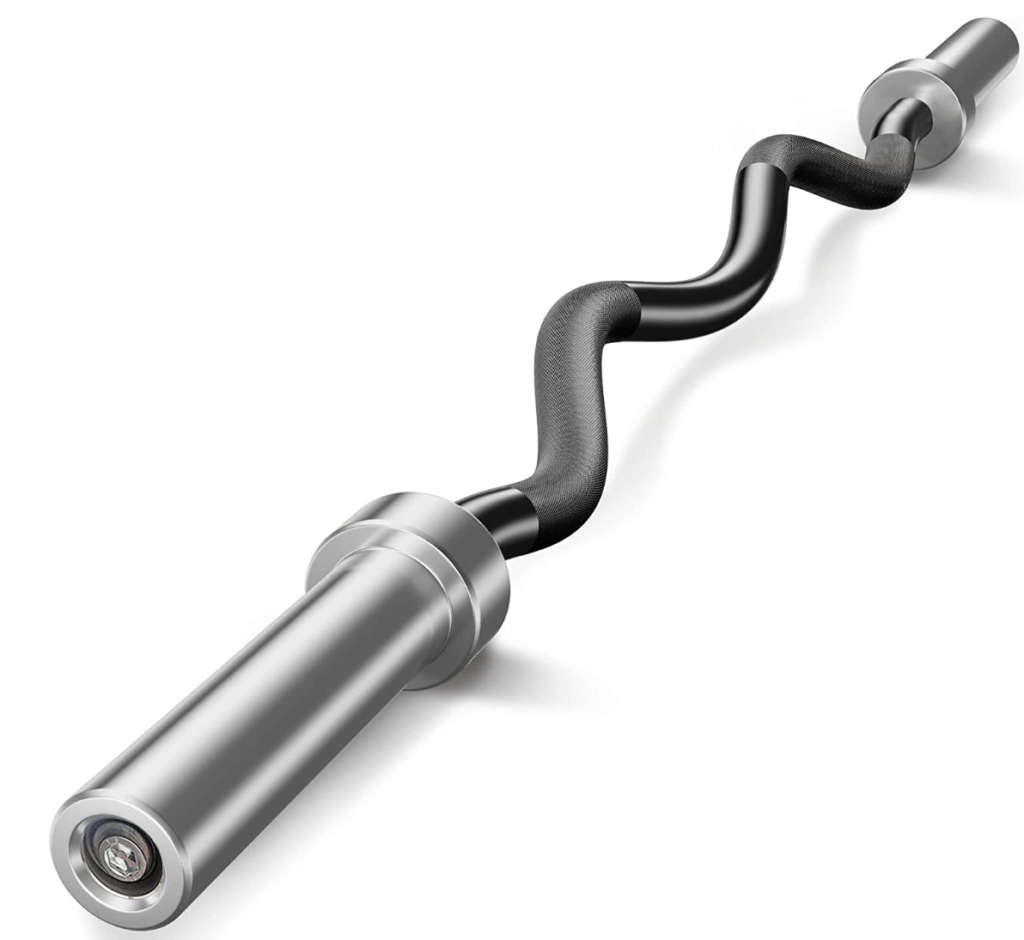
The Curl Bar/EZ Bar is a specialized piece of gym equipment that is designed to help you perform a variety of exercises that target your upper body muscles.
It consists of a long, curved bar with handles on each end, allowing you to easily grip it and perform various curl movements to target your biceps, triceps, and other upper body muscles.
| Pros | Cons |
| For one, these types of bars are often more comfortable to grip and hold onto, making them ideal for users with wrist pain or other issues that can make weight lifting more challenging. | Some people have difficulty gripping and controlling the bar, as well as increased pressure on the hands and wrists. |
| The angled shape of a curl bar or EZ bar allows you to target specific muscle groups more effectively than traditional straight bars. | The curved design may feel awkward to grip. |
| Many curl bars and EZ bars come with extra features such as collars or attachment points for weight plates, which can help increase the range of exercises that you can perform with these tools. | – |
Exercises For The Curl Bar/Ez Bar
Isolated Bicep Curls
One of the most popular exercises that you can do with a curl bar or EZ bar is bicep curls.
To perform this exercise:
- Start by gripping the handles of the bar with your palms facing forward.
- Slowly bend at the elbow and raise the bar towards your chest, keeping your upper arms stationary as you perform the movement.
- Pause briefly at the top of the movement, then slowly lower the bar back to starting position and repeat as needed.
Hammer Curls
Another great exercise for your biceps with a curl bar or EZ bar is hammer curls, which can help to build strength and definition in this muscle group.
To perform hammer curls:
- Start by gripping the handles of the bar with your palms facing each other.
- Bend at the elbows and raise the bar towards your chest, keeping your upper arms stationary as you perform the movement.
- Slowly lower the bar back to starting position, pausing briefly at the top of the movement. Repeat as needed.
Reverse Curls
To target your triceps with a curl bar or EZ bar, try reverse curls. This exercise can help build strength and definition in this large muscle group.
- Start by gripping the handles of the bar with your palms facing down towards the ground.
- Bend at the elbows and raise the bar towards your chest, keeping your upper arms stationary as you perform the movement.
- After you pause at the top of the movement, lower the bar back to starting position and repeat.
11. Safety Squat Bar

If you’re looking for a more specialized bar to help build strength and power in your lower body, the safety squat bar may be a great option.
This piece of gym equipment is designed specifically for squat movements, allowing you to target and isolate this large muscle group with greater ease.
The safety squat bar features two curved grips on each end and has a central handle that allows you to hold it comfortably on your upper back.
This unique design helps to distribute the weight of the bar across your shoulders, allowing you to perform squats with greater ease, even if you have a history of lower body injuries or mobility issues.
| Pros | Cons |
| One major advantage of using a safety squat barbell at the gym is that it streamlines the squatting motion, making it easier to focus on your form and technique. | Some individuals may experience discomfort or even bruising from the pressure created by the bar on their shoulders and neck. |
Exercises For The Safety Squat Bar
Box Squats
One of the best exercises you can do with a safety squat bar is box squats. This movement helps to build strength and power in your lower body, as well as engage multiple muscle groups throughout your core and upper body.
To perform box squats on the safety squat bar:
- Start by setting up a sturdy box or bench behind you.
- Grip the bar with your hands slightly wider than shoulder-width apart, and position it across your upper back so that you are comfortably holding the center handle.
- Slowly lower yourself down onto the box or bench, bending at the hips and knees as you descend.
- Do not sit all the way down on the bench – stop just before you reach it.
- Pause briefly, then use your hamstrings and glutes to push yourself back up to starting position.
12. Log Bar

The unique design of this log barbell features a hexagonal shape that is much wider than traditional barbells, providing more stability for heavy lifts. It also comes with two types of grips – a center handle and curved grips on each end.
Many log barbells also include adjustable weights that can be added or removed to suit your workout needs.
| Pros | Cons |
| A log bar offers increased stability and balance due to its design. Since the weight is evenly distributed across the length of the bar, users will be less likely to experience issues with shifting or tipping during their lifts, which can help prevent injuries or accidents. | Some users also find that log barbells are less versatile than other types of weights or resistance training tools, since they only focus on one particular type of movement. |
Exercises For The Log Bar
Jerks
A great exercise to try with a log bar is jerks. This movement targets your shoulders, upper back, and core, engaging multiple muscle groups for a total-body workout.
To perform jerks with a log bar:
- Start by gripping the bar with your hands slightly wider than shoulder-width apart.
- Bend your knees slightly and use your legs to lift the bar up to shoulder height.
- Then, press the bar overhead as you straighten your legs and hips, using your arms to help propel the bar upwards.
- Lastly, lower the bar back to where it started and repeat the process for as many reps as you want.
13. Swiss Bar/Football Bar

A swiss / football bar is a type of weightlifting equipment that is used to build strength and muscle mass in the upper body.
This specialized piece of equipment consists of a long, straight bar with two parallel handles at either end. It can be used for a variety of exercises that target different muscles in the arms, chest, back, and shoulders.
| Pros | Cons |
| Allows you to easily achieve a full range of motion for both pressing and pulling movements, making it ideal for targeting all major muscle groups in the body. | Some users may find the unique design to be uncomfortable or difficult to use, particularly for exercises such as bicep curls. |
| Additionally, because the swiss/football bar features angled grips that encourage proper wrist alignment during exercises, it can help minimize strain and reduce the risk of injury. | – |
Exercises For The Swiss Bar/Football Bar
Incline Press
To perform the incline press with a swiss/football bar:
- Start by sitting on a bench or chair with the bar across your upper chest.
- Grip the handles of the bar with your hands slightly wider than shoulder-width apart.
- Then, press the bar upwards until your arms are straight.
- Lower the bar back down to the starting position, keeping your elbows tucked in close to your body throughout the movement.
Single-Leg Deadlift
Another great exercise to try with a swiss/football bar is the single-leg deadlift.
To do this:
- Stand on one leg, with the other leg extended behind you.
Keeping your core engaged, slowly bend forward at the hips and lower your torso towards the ground, extending your free leg out behind you for balance.
- When you reach the bottom of this movement, pause for a moment before lifting yourself back to the starting position.
- Repeat on the other side.
The Parts And Features Of A Barbell
Some specific types of barbells may be designed for certain workouts or lifts such as Olympic lifting or CrossFit training.
However, regardless of their purpose or intended use, all barbells share the same basic anatomy and function.
Sleeves

The sleeves are the cylindrical ends of the bar that simply hold the weight plates. They can be either threaded or smooth, with threaded sleeves typically being more durable and sturdy.
Whip

While the sleeves hold the weight plates, the whip is what allows you to actually lift them. This refers to the flexibility or “bendiness” of the bar, and is generally determined by its material and design.
Collars

These are the devices that secure the weight plates to the sleeves, keeping them in place and preventing them from sliding or falling off. They can be either fixed or adjustable types, with the latter being more commonly used for Olympic lifting.
Grips

The grips of the bar allow you to hold it comfortably while lifting. They can either be smooth or textured, depending on your preference, and are typically made from either metal, plastic, or rubber. You can also purchase a pair of grips for extra comfort while lifting.
Loading Capacity
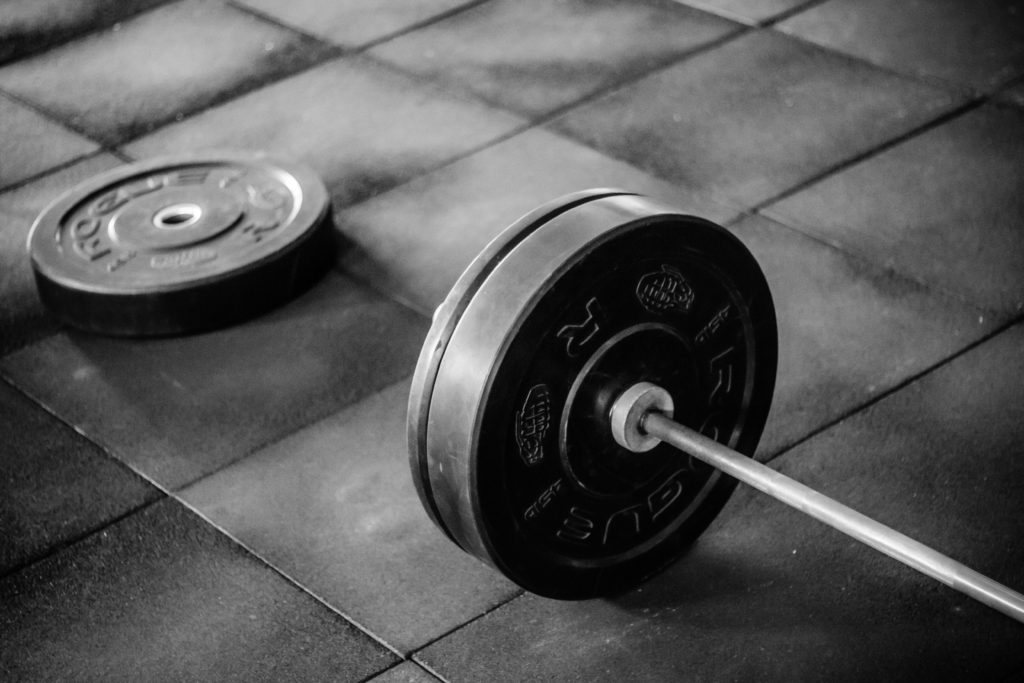
The loading capacity of a barbell refers to the maximum amount of weight it can safely support during your workouts.
This is often determined by the types of weight plates you use with the bar, as well as their combined weight.
Generally speaking, a standard barbell will be able to support anywhere from 50-100 pounds, depending on its length and age.
Knurling
Knurling refers to the types of grooves or patterns on the bar’s grips, and can be either light, medium, or heavy.
Finish
The finish of a barbell refers to the types of materials it is coated in, and can affect its overall performance and durability. Some common types of finishes include chrome, zinc, powder coat, and black oxide.
FAQs
Why are there different types of barbells?
Different types of barbells exist to serve various purposes for the person lifting them.
For example, some types of barbells are designed specifically for Olympic weightlifting, while others may be better suited for CrossFit or other types of high-intensity training.
How do I identify my barbell?
There are several factors that can help you identify your barbell, including its material, length, weight capacity, knurling type, and finish.
You can also pay attention to any manufacturer or brand markings that may be present on the barbell itself, as these can often provide helpful information.
What barbell do gyms use?
Gyms typically use standard barbells, which tend to be longer, thicker, and heavier than other types of barbells.
These types of barbells may also have adjustable collars or other types of features that allow them to safely support heavier loads.
Are barbells or dumbells better?
There is no definitive answer to this question, as different types of barbells and dumbbells may be better suited for certain types of workouts or types of weightlifting.
That being said, barbells typically provide more versatility and are often preferred by advanced or professional lifters due to their longer length and greater range of motion.
What bar is best for Deadlifting?
The deadlift bar is the best option for deadlifts since it is made specifically for deadlifts. This bar typically has less knurling than standard barbells, which can help reduce friction and prevent your hands from slipping or sliding during your lifts.
Which barbell to use for squats?
The safety squat bar is ultimately the best option for squats, as it provides excellent support and stability when lifting heavy weight.
What type of barbell should I get?
There is no one “best” type of barbell for everyone, as different types of barbells may be better suited to your specific needs and fitness goals.
To choose the right barbell for you, consider factors such as your experience level, the types of exercises you plan to perform, and the weight you plan to lift.
What barbell weight should I start with?
It is generally recommended to start with a lighter weight when beginning your lifting routine, and then gradually increase the load as you become more comfortable with your form and technique.
How do I choose a barbell size?
Different types of barbells may be better suited to different types of workouts, body types, and lifting goals.
To choose the right barbell size for you, consider factors like your height, weight, and fitness experience level, as well as the types of exercises you plan to perform.
How much is a EZ bar?
You can typically expect to pay anywhere from $50-$200 for an EZ bar, with more premium or specialized types of bars costing more.
Can I deadlift with EZ bar?
Yes, you can definitely deadlift with an EZ bar. However, it is important to choose a weight that is appropriate for your skill level and experience, as this will help ensure that your form and technique are correct, and prevent you from straining or injuring yourself.
Is EZ bar better than straight bar?
Some people may find that an EZ bar is easier or more comfortable to use compared to a straight bar, due to its curved shape and angled grips.
What are curved barbells for?
Curved barbells are typically designed for use in weightlifting and bodybuilding, and can help provide greater support and stability during heavy lifts.
They can also help reduce the risk of injury or strain to your wrists, elbows, and shoulders. Some types of curved barbells may be designed specifically for use during deadlifts, squats, and other types of lifts.
